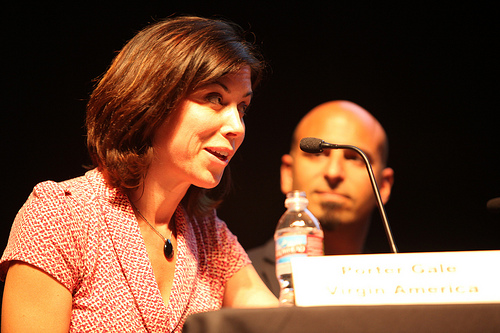
Social Media has evolved beyond a series of platforms that enable content publishing, sharing, and discovery into a genuine, peer-to-peer looking glass into the real world conversations that affect the perception, engagement, and overall direction of the brands we represent.
Socialized media didn’t invent “conversations,” it simply organized and amplified them and established an opportunity for learning and collaboration.
Twitter and Twitter Search have ushered in a new genre of not only communications and associated search technology, but also dedicated ecosystems that transform and support how we as consumers share and discover relevant information in real-time.
Online discussions, rants, and observations are either alarming (and motivating) brand managers or fooling them into unforeseen enthrallment. But the reality is that real-time dialogue is fueling connections and perceptions in the statusphere, blogopsphere, online communities, and the social web in general. It’s this swelling tsunami of chatter that will only intensify and heighten as it forces a new genre of Social Customer Relationship Management (sCRM). Social CRM is no longer an option. It necessitates brand involvement to proactively share answers, solve problems, establish authority, and build relationships and loyalty, one tweet, blog post, update, and “like,” at a time.
In the world of business, social media, led by Twitter, is forcing companies to augment the offshoring of reactive customer service with the nearshoring of proactive customer engagement. The conversations that power social media are sparking a sense of urgency to identify influential voices and talk to customers in a place and time of their choosing (generally, in public and online).
For example, on Friday at during a panel at the CrunchUp on Real Time Business, Porter Gale, vice president of marketing for Virgin America, made it clear that Virgin America understands the promise, prospect, and value of listening and responding to the social stream.
Erick Schonfeld, who was moderating, asked Porter how her team mines Twitter for the perception of the brand and also for determining how they contact customers.
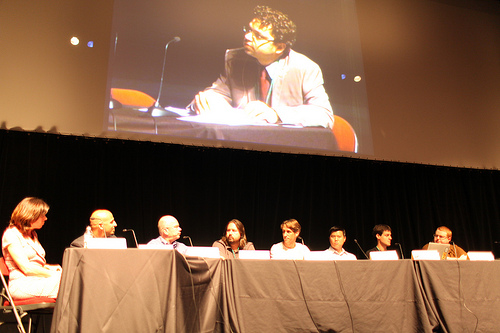
Porter revealed that the Virgin America team is small and applies roughly the equivalent of 1.5 people to monitoring and engaging on Twitter and other social networks. To her and the team, social media is representative of not only a listening system, but also a complete engagement channel. The word “marketing” doesn’t even enter the mix.
With more than 20,000 followers on Twitter, Virgin America is galvanizing a vibrant and active community of people who will respond in “Twitter time,” thus alleviating the modest team from having to engage in every discussion, whether it’s positive or negative.
The most common example Porter shared was a response to the question, “Should I fly Virgin?”
“The community closes the sale,” exclaimed Porter.
She also shared a story of how Virgin America invests in the good will of customers, simply by publicly acknowledging and supporting them in the same channels where they’re communicating.
During one flight, a woman who just graduated medical school to become a doctor, had tweeted her excitement about graduating and also flying @virginamerica. Instead of simply responding with a congratulatory Tweet, Porter and her team retweeted and asked someone on the flight to buy her a drink (the benefits of offering inflight wifi).
To her surprise, Porter triggered an immediate response, “Row 11 is going to buy her a drink.” And, to her further astonishment, the person who sent that Tweet was live in the audience at the Real-Time stream event.
Alexia Tsotsis, tech writer at the LA Weekly, shouted from the first row, “That was me!”
Everyone in the audience was a witness to a vivid demonstration of how interaction online extends into real world experiences.
More impressive is Virgin America’s use of the social Web for real-time customer service. They’re actively monitoring issues, frustrations, and recommendations to solve challenges as they arise. In several such instances, Virgin America has used Twitter as a real-time guest service recovery system in flight to address concerns and problems by contacting service staff in the air to alert them to issues – again, the perils and associated benefits of offering inflight WiFi.
Earlier in the day, Peoplebrowsr (disclosure: I am an advisor) showed a demo in which airlines were ranked by the sentiment expressed about each brand on Twitter, and Virgin America was on top. Peoplebrowsr highlighted the ability to analyze conversational sentiment by industry through the alignment of positive, neutral, and negative conversations and perception by brand.
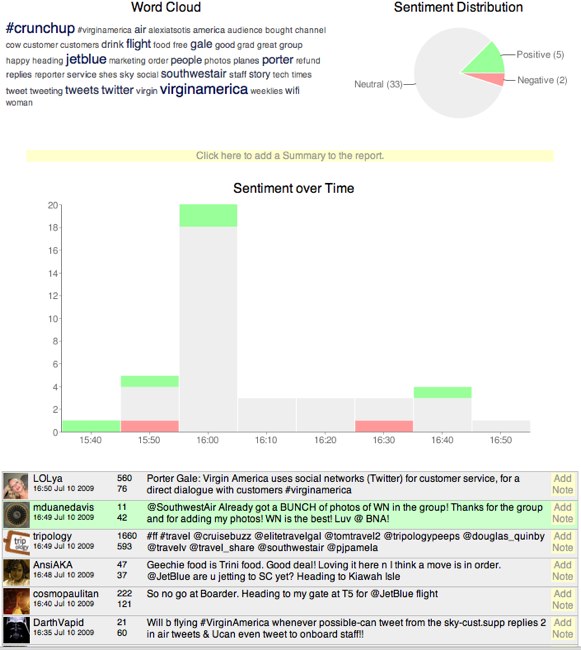
Ross Mayfield, CEO and founder of Socialtext, discussed the nature of the social dialogue enterprises are being pulled into and how conversations require more than one person or department to engage. SocialText offers a dashboard for enterprises that wish to collaborate internally with coworkers and externally with customers and stakeholders.
Ross referenced the engagement iceberg, where he observes only a small portion of customer conversations and engagement as truly visible, with most occurring beneath the water line and thus, out of view.
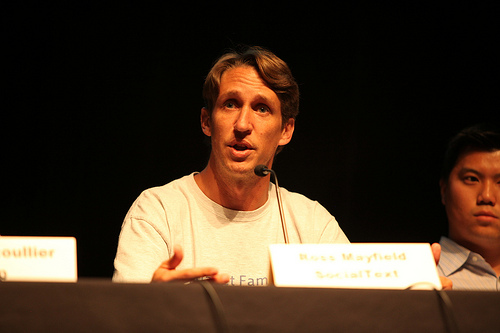
He’ s right. In my research and experience, we’ve identified that every online conversation worthy of response directly matched specific divisions within an organization and usually rank in this order:
1. Support
2. PR
3. Marketing
4. Sales
It highlights the reality that every department eventually needs to socialize.
Ross then asked his fellow panel members as well as the audience, “Who’s going to own Social Media and the process of responding?”
My answer: No one.
Social Media is, for the time being, tuning-in new channels of influence to incorporate into the brand and marketing mix. While it takes a station manager time to receive the signals and in turn, coordinate outward broadcasts, it is the divisions within each organization that will need to shift from an introspective support mode to an extrospective group of proactive collaborators.
But as Ross cautioned businesses and eager social media teams, “Before they collaborate with the community, they have to collaborate with themselves.”
If responsibilities and workflow isn’t established and most importantly, if guidelines aren’t drafted and disseminated company-wide, the intention of helping influential customers and advocates can quickly transcend into social, and very public, chaos.
We need rules of engagement.
As Erick pointed out in the discussion, “It used to be unhappy customers who would call into customer service lines to express frustration. Now if businesses don’t immediately respond with a resolution and nip these issues in the bud, they have the potential of spreading and getting out of control. At the same time, companies need to identify and amplify praise as it happens.”
Virgin America’s Porter Gale is trying to rally her team as well as the other departments that are affected by real-time conversations and the issues they raise. She hosts brownbag lunches, where PR, customer service, and other teammates discuss what’s happening with Twitter and other social networks. They also share and review strategies and tactics to teach and learn from each other based on their experiences.
There are social networks, and there are tools with which to identify conversations and facilitate interaction, but everyone agreed, that in the world of new service and marketing, we need to improve the literacy and education among the teams who occupy the front lines.
The “now” web is powerful. It’s building new bridges, networks, and channels. It’s absolutely changing the way people communicate, research, and ultimately make decisions.
Yes, the real-time Web is powered by conversations. But, what’s important to remember, is that conversations are personal and therefore sacred.
Broadcasting messages, or even worse, sponsored messages as a form of resolution or participation is foolhardy.
Companies such as Pizza Hut that relegate Twitter interaction to a summer “Twintern” will indubitably get what they pay for. We’ve already witnessed the public backlash when a twintern abuses Twitter on behalf of an unsuspecting brand. #habitat
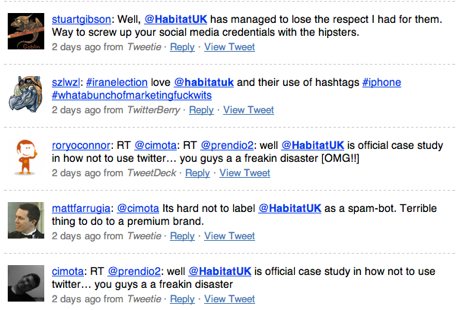
The point is that it’s not whether or not an intern or junior staffer on the marketing and communications team is competent or incompetent. The reality is that businesses should view the role of engaging with customers, prospects and influencers as a strategic competitive advantage as well as an earned privilege.
As panelist Maynard Webb of LiveOps pointed out, “A brand can get damaged faster than ever nowadays.”
The true shift represented by the social and real-time Web is not simply the ability to surface relevant conversations as they happen, it represents the opportunity to learn from public sentiment and create a more aware and adaptive organization that leads communities through action.
Monitoring the conversation is not enough. Brands need to jump in, but in a professional way.